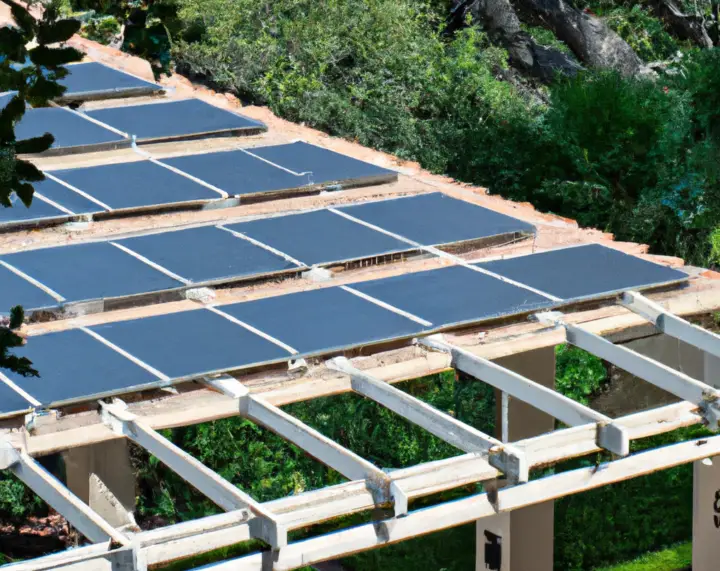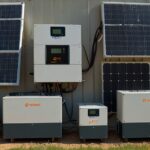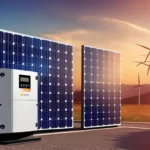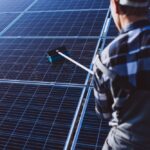If you are looking for ways to maximize your home’s energy efficiency, one of the most effective options is to add a solar panel patio roof. Solar energy is a clean and sustainable source of power that can significantly reduce your reliance on fossil fuels and lower your energy bills.
In this guide, we will delve into the benefits of solar panel patio roof, factors to consider when choosing a solar panel patio roof, offer a step-by-step guide to installation, provide maintenance tips, address the cost and incentives associated with installation, and debunk common misconceptions about solar energy and home efficiency.
Benefits of Solar Panel Patio Roofs
Having a solar patio roof at your home offer a slew of benefits. Some major benefits are mentioned below:
-
Clean and Renewable Energy
One of the main benefits of solar panel patio roofs is that they provide clean and renewable energy. By harnessing the power of the sun, solar panels generate electricity without producing harmful emissions or pollution. This means that solar panel patio roofs can significantly reduce your carbon footprint and contribute to a cleaner, healthier environment.
Additionally, solar energy is a renewable resource, which means that it can be continually replenished and is not subject to the same price fluctuations and supply limitations as traditional energy sources. By generating your own electricity with a solar panel patio roof, you can reduce your dependence on fossil fuels and potentially save money on energy bills in the long run.
-
Reduced Energy Costs
In addition to providing clean energy, solar panel patio roofs can also help reduce your energy costs. By generating your own electricity, you can potentially lower your reliance on traditional energy sources and reduce your monthly energy bills. This is especially beneficial for those who use a lot of energy in their outdoor living spaces, such as for lighting, heating, or cooling.
-
Increased Home Value
Solar panel patio roofs can also increase the value of your home. As more and more homebuyers prioritize energy efficiency and sustainability, solar panel patio roofs can be a selling point for potential buyers who are looking for environmentally friendly and cost-effective features. According to a report by the National Renewable Energy Laboratory, homes with solar panels sell faster and for more money than those without.
-
Protection from the Elements
In addition to generating electricity, solar panel patio roofs provide shade and protection from the sun, rain, and other elements. This can help keep your outdoor living space comfortable and protected, while also reducing your reliance on traditional patio covers or other structures that do not generate electricity. By providing both energy and protection, solar panel patio roofs offer a versatile and functional addition to any home.
Factors to Consider Before Installing a Solar Panel Patio Roof
Though solar patio cover kit can be a great addition to your house, there are still some factors to consider.
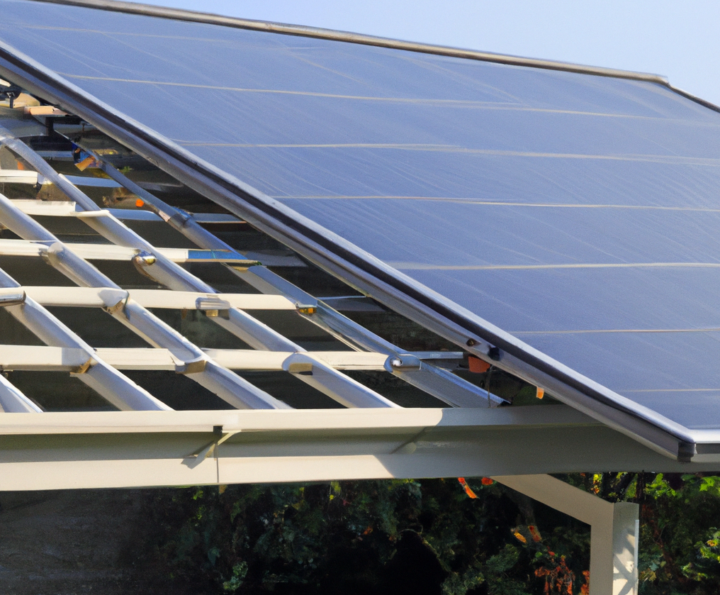
Energy Needs
The first factor to consider before installing a solar panel patio roof is your energy needs. How much energy do you use in your outdoor living space, and how much do you want to generate with your solar panel patio roof? This will depend on the types of outdoor appliances and equipment you use, such as lighting, heating, or cooling systems, as well as your personal preferences and energy goals.
To determine your energy needs, you can consult with a solar panel installer or use an online energy calculator. This will help you determine the size and capacity of your solar panel patio roof, as well as estimate the potential energy savings and return on investment.
Roof Orientation
Another important factor to consider is the orientation and angle of your roof. Solar panels work best when they are installed on a south-facing roof with a pitch of 30 to 45 degrees. If your roof faces a different direction or has a lower pitch, you may need to adjust the angle of your solar panels or install additional panels to compensate for the lower energy production.
It’s also important to consider any shading or obstructions on your roof, such as trees or nearby buildings, that could affect the performance of your solar panels. A solar panel installer can help assess your roof’s orientation and potential shading issues to ensure optimal energy production.
Installation Costs
The cost of installing a solar panel patio roof will depend on several factors, such as the size and capacity of your solar panels, the type of roofing material used, and any additional installation or permitting fees. It’s important to consider these costs and determine whether the potential energy savings and return on investment make the installation worthwhile.
In addition, you may be eligible for government incentives or rebates for installing solar panels, which can help offset some of the installation costs. A solar panel installer can help you explore these options and determine the best financing and payment plan for your solar panel patio roof.
Local Regulations and Permits
Before installing a solar panel patio roof, it’s important to research and comply with any local regulations and permits. This may include building codes, zoning regulations, and electrical permits. Failure to comply with these regulations can result in fines, delays, or even the removal of your solar panels.
A solar panel installer can help guide you through the permit and installation process and ensure that your solar panel patio roof is compliant with local regulations.
By considering these factors before installing a solar panel patio roof, you can ensure a successful and cost-effective installation that meets your energy needs and goals.
Types of Solar Panel Patio Roofs
Attached Solar Panel Patio Roofs
Attached solar panel patio roofs are designed to be installed directly onto an existing structure, such as a house or garage. These roofs typically have a sloped design and are attached to the side of the structure, providing both energy and protection from the elements.
Attached solar panel patio roofs can be a great option for homeowners who want to maximize their energy production and integrate their solar panels seamlessly into their home’s design. They are also typically more cost-effective than standalone solar panel patio roofs since they require fewer materials and installation time.
Standalone Solar Panel Patio Roofs
Standalone solar panel patio roofs are designed to be freestanding structures that can be installed anywhere in your outdoor living space. These roofs typically have a flat or slightly sloped design and are supported by columns or posts, providing shade and protection from the elements while also generating electricity.
Standalone solar panel patio roofs can be a great option for homeowners who want to create a dedicated outdoor living space and incorporate solar energy into their design. They are also more flexible in terms of placement and can be customized to fit your unique energy and design needs.
Integrated Solar Panel Patio Roofs
Integrated solar panel patio roofs are designed to be integrated into an existing patio cover or pergola structure. These roofs typically feature solar panels that are seamlessly integrated into the structure’s design, providing both energy and protection from the elements.
Integrated solar panel patio roofs can be a great option for homeowners who already have a solar patio cover or pergola structure and want to integrate solar energy into their design. They can also be more aesthetically pleasing than standalone solar panel patio roofs since they blend seamlessly into the existing structure.
Adjustable Solar Panel Patio Roofs
Adjustable solar panel patio roofs are designed to be adjustable based on the angle of the sun and the homeowner’s energy needs. These roofs typically feature solar panels that can be tilted or adjusted to maximize energy production, while also providing shade and protection from the elements.
Adjustable solar panel patio roofs can be a great option for homeowners who live in areas with variable weather patterns or want to optimize their energy production throughout the year. They can also be more energy-efficient than fixed solar panel patio roofs since they can be adjusted to match the sun’s angle and intensity.
The Installation Process for a Solar Panel Patio Roof
The installation process of a solar panel patio cover typically involves the following steps:
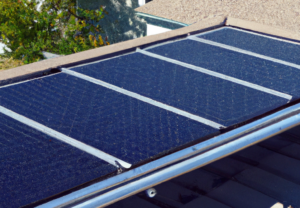
Site Assessment
The first step in the installation process is to assess the site where the solar panel patio roof will be installed. This includes evaluating the available space, determining the orientation and tilt of the panels for optimal energy production, and identifying any shading or obstruction issues that could affect the panels’ performance.
Design and Permitting
Once the site assessment is complete, the next step is to design the solar panel patio roof and obtain any necessary permits from the local building department. The design will typically include the layout of the panels, the type of roofing material, and the placement of any supporting structures.
Roof Preparation
Before the solar panel patio roof can be installed, the existing roof or patio structure may need to be modified or reinforced to accommodate the weight of the solar panels. This may involve adding additional supports or strengthening the existing structure to ensure it can support the panels’ weight and withstand any wind or weather conditions.
Solar Panel Installation
Once the roof or patio structure is prepared, the solar panels can be installed. This typically involves attaching the panels to the supporting structure using specialized mounting hardware and wiring them together to form a complete solar array. The wiring will then be connected to an inverter, which converts the DC power generated by the panels into usable AC power for your home.
Read our detailed guide on DIY solar panel patio cover.
Electrical and Building Inspection
After the solar panel patio roof is installed, it will need to be inspected by a licensed electrician and a building inspector to ensure it meets all local building and safety codes. This will include verifying that the electrical wiring is properly installed and that the roof structure is sound and secure.
System Activation
Once the solar panel patio roof has passed all inspections, it can be activated and connected to the electrical grid. This will typically involve working with your utility company to have the system inspected and approved for connection to the grid, as well as setting up any necessary monitoring or control systems to track the system’s performance.
Overall, the installation process for a solar panel patio roof can take several weeks to complete, depending on the complexity of the project and any necessary modifications to the existing roof or patio structure. Working with a qualified solar panel installer can help ensure the process goes smoothly and that your new solar panel patio roof is installed safely and efficiently.
Maintenance Tips for Your Solar Panel Patio Roof
Maintaining your solar panel patio roof is important to ensure that it continues to operate at peak efficiency for many years to come. To keep your system functioning properly, you should regularly inspect the panels for any damage or dirt buildup, which can reduce their energy output. You should also trim any nearby trees or foliage that may be shading your panels, and clean them periodically with a gentle soap and water solution. Additionally, you should have your system inspected by a professional installer every few years to ensure that it is functioning properly and that any necessary repairs or upgrades are made.
The Cost of Adding a Solar Panel Patio Roof: Is It Worth It?
The cost of adding a solar panel patio roof can vary depending on several factors, such as the size of your home, the amount of energy you need, and the type of panels you choose. However, the upfront costs of installation are often offset by the long-term energy savings that come from using solar energy.
In many cases, homeowners can recoup their investment within several years, depending on the specifics of their system and the available incentives and rebates. Additionally, adding a solar panel patio roof can increase the value of your home, as many homebuyers are willing to pay more for a home with sustainable and cost-effective energy systems.
Tax Incentives and Rebates for Installing a Solar Panel Patio Roof
There are several tax incentives and rebates available for homeowners who install a solar panel patio roof. The federal government currently offers a tax credit equal to 26% of the cost of installation, which can significantly reduce the upfront cost of the system. Additionally, many states and local governments offer further incentives, such as property tax exemptions and rebates. You should consult with a professional installer to determine what incentives are available in your area.
How to Monitor Your Energy Savings with a Solar Panel Patio Roof
One of the benefits of installing a solar panel patio roof is the ability to monitor your energy usage and savings. Many systems come equipped with online monitoring tools that allow you to track your energy production and usage in real-time.
This can help you identify potential issues with your system and make adjustments to optimize your energy savings.
Common Misconceptions About Solar Energy and Home Efficiency
There are several common misconceptions about solar energy and home efficiency that can prevent homeowners from taking advantage of this sustainable and cost-effective energy source. One of the most common misconceptions is that solar panels are not effective in cloudy or overcast conditions.
While it is true that solar panels generate more energy in direct sunlight, they can still produce electricity even on cloudy days. Additionally, many modern solar panels are designed to be more efficient in lower light conditions. Another misconception is that solar panel installation is too expensive or complicated. While the upfront costs of installation can be significant, the long-term savings and potential tax incentives can make it a worthwhile investment for many homeowners. Additionally, many installers offer financing options to help make solar panel installation more accessible for homeowners.
In conclusion, adding a solar panel patio roof is an effective and sustainable way to maximize your home’s energy efficiency. By considering the factors outlined in this guide, you can choose a system that meets your energy needs and provides long-term benefits for your home and the environment. With the help of a professional installer and some basic maintenance, you can enjoy reliable and cost-effective energy for years to come.

